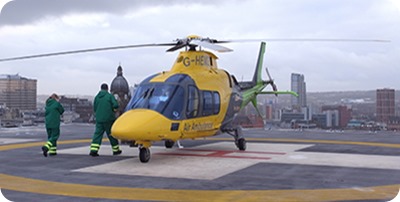Embrace, the Yorkshire and Humber Infant and Children's inter-hospital transfer service wanted to determine the potential benefit of using a dedicated aero medical response for the region's neonatal and paediatric patients.

They approached senior lecturer David Clegg from Sheffield Hallam University’s Materials and Engineering Research Institute, who, together with a PhD student developed a simulation model to assess the difference in service between using dedicated helicopters and the traditional land-based ambulance service. In particular they were trying to determine whether dedicated helicopters would reduce transfer times compared to the uncommitted service currently in operation.
The experiments demonstrated that of the 47 opportunities for patients to be transferred by helicopter, on 29 occasions a helicopter would not be available to perform the transfer. This meant that 62% of patients had to go without the aeromedical response where a helicopter could have reduced the amount of time it took for them to reach specialist emergency medical treatment.
The experiments also established that 93% of potential journeys could be accessed by a dedicated helicopter service where road transfers would take more than 90 minutes.
The research has helped Embrace to develop an improved aeromedical service which focuses on the care of potentially vulnerable patients, such as children. The findings were presented at a conference in May 2013 to highlight the benefits to a wider audience. The model can be adjusted for other regions, so it's likely that the work will have even more impact in the future.
Embrace began using the dedicated helicopter service in May 2013, which is provided by The Children's Air Ambulance. In addition to a reduction in patient journey and waiting times, it is contributing to a higher level of clinical care.
Ian Braithwaite, Senior Transport Nurse at Embrace said;
"Working with the Research Institute was a very positive experience for us. Their advanced simulation modelling provided us with an understanding of our activity which we could not have achieved independently. This allowed us to reassure our aircraft providers that our expected helicopter utilisation could be integrated with their existing operations. The involvement of an outside partner in the data analysis provided some valuable perspective within the project. We look forward to further opportunities to work with the team at the University."
Project supported by Innovation Futures.